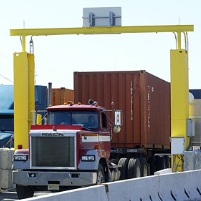U.S. Ports and Borders Still Vulnerable to Terrorism
Wednesday, November 25, 2009
 Advanced Spectroscopic Portal (photo: White House)
Advanced Spectroscopic Portal (photo: White House)
Seven years and $3 billion later, the Department of Homeland Security is still relying on technology at U.S. ports and border crossings that can’t distinguish bananas from a nuclear bomb being smuggled into the country. By now, federal officials were supposed to have installed a new generation of radiation detection devices (known as the Advanced Spectroscopic Portal monitor system), but the department failed to meet its own fall deadline. Eventually, 1,400 new machines are supposed to be installed across the country at a cost of $1.2 billion.
In their defense, homeland security officials claim the old detection equipment scans 98% of all “arriving seaborne container cargo and all vehicles that enter the United States.” But scanning is one thing, and accurately determining the contents of all crates and containers is another. A Government Accountability Office nuclear detector expert told Congress recently that the existing technology in place at ports and border crossings “can be set off even by shipments of bananas, kitty litter, or granite tile because these materials contain small amounts of benign, naturally occurring radioactive material.”
-Noel Brinkerhoff
Homeland Security Misses Self-Imposed Schedule to Certify New Radiation Detectors (by Martin Matishak, Global Security Newswire)
U.S. Ports Still Wide Open to Nukes, Report Says (by Jeff Stein, Huffington Post)
Combating Nuclear Smuggling: Recent Testing Raises Issues About the Potential Effectiveness of Advanced Radiation Detection Portal Monitors (Government Accountability Office) (PDF)
- Top Stories
- Unusual News
- Where is the Money Going?
- Controversies
- U.S. and the World
- Appointments and Resignations
- Latest News
- Donald Trump Has a Mental Health Problem and It Has a Name
- Trump Goes on Renaming Frenzy
- Trump Deports JD Vance and His Wife
- Trump Offers to Return Alaska to Russia
- Musk and Trump Fire Members of Congress






Comments